Who benefits from Bill 5?
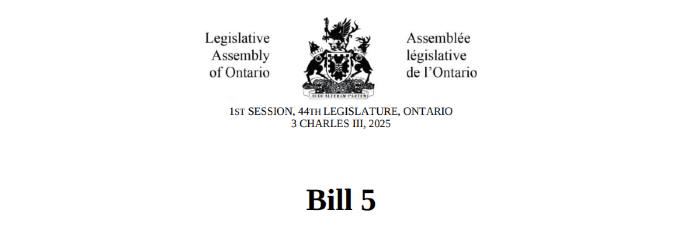
Part 1: Special favours, energy and critical minerals
We have been trying to get this article out for a couple of weeks now, and the ground has been shifting under our feet. As we publish this (on June 5, 2025) Bill 5 has passed, despite widespread condemnation from Indigenous groups, those who care about the environment, and those who care about law and democracy.
This is part one of our series on Bill 5, with a second part to come next week.
Bill 5, which the Ford government called “Protect Ontario by Unleashing our Economy Act, 2025”, was tabled by Stephen Lecce, Minister of Energy and Mines. It’s the Ford government’s most audacious land and power grab, and the biggest erasure of democracy and rule of law they have attempted.
Bill 5 is a beast. Though it has been positioned as being about mining, it makes changes to a list of other acts, some of which are completely unrelated to mining.
One such example is an amendment to the Rebuilding Ontario Place Act, 2023. That amendment removes all public consultation and environmental oversight rules from Ontario Place, in order to speed up the “redevelopment” process there. (As we wrote in an earlier article, Therme is made up of Ford’s ex-staffers and other political operatives, building a casino disguised as a “spa.”)
Here is the entire list of existing acts affected and modified by Bill 5.
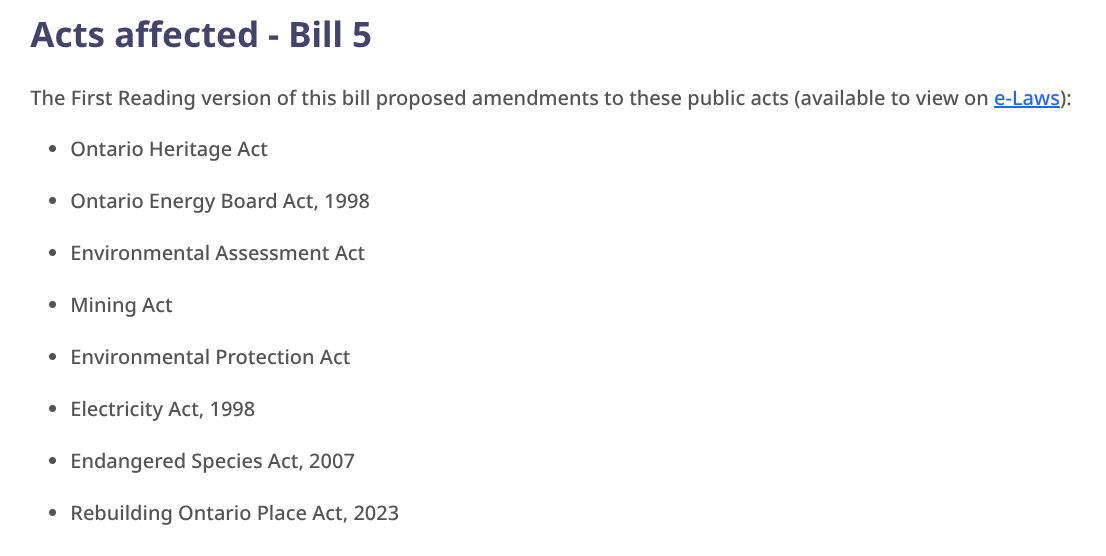
The bill also removes environmental oversight for two very specific locations via amendments to the Environmental Assessment Act - the proposed Eagle’s Nest mine, and the Chatham-Kent landfill site known as Dresden landfill.
Eagle’s Nest is part of the Ring of Fire, where mining rights are controlled by Wyloo, owned by Australian billionaire Andrew Forrest. The site contains 17 million tonnes of nickel, copper and platinum, as well as the world’s largest chromite deposits outside of South Africa.
The Ring of Fire region contains minerals essential for energy, defense and high-tech manufacturing. Nickel is required for EV batteries, electronics and aerospace components. The region holds the largest known chromite deposit in North America, which is required for stainless steel production. Cobalt is needed for defense electronics and radar systems. Hydrogen fuel cells and catalytic converters require platinum. Copper is needed for wiring, EV charging stations, solar panels, wind turbines and construction materials. Many of the world’s largest companies and fastest growing sectors require raw materials that could be extracted from the Ring of Fire.
Though mining firms stand to profit directly from mining in the Ring of Fire, infrastructure and construction firms will be awarded massive contracts to build needed roads, railways, power lines and processing facilities. Companies in engineering, construction and logistics all stand to benefit.
Global technology companies and electric vehicle companies also benefit from a stable supply of minerals for their batteries and electronics. Companies like Elon Musk’s Tesla, GM, Ford and battery makers are likely beneficiaries of mining in the region.
The Chatham-Kent landfill was controlled until recently by York1 Environmental Solutions, a private company in Mississauga. The site was sold earlier this year to Brian Brunetti, president and COO of York1, along with Andrew Guizzetti and Daniel Guizzetti, brothers who founded Empire Communities, a builder of master-planned communities. York1 had filed plans to reopen the dormant 85-acre landfill and bring in over 6,000 tonnes of construction waste per day.
Just last week, the municipality of Chatham-Kent accused York1 of trying to rebrand the project, calling out a new website - Sustainable Dresden - launched by the company. The spokesperson for York1 is Doug Ford’s former director of communications, Laryssa Waler. (Waler, frequently a pundit on CBC’s Power and Politics, CP24 and CTV News, is a commissioner of the Niagara Falls Bridge Commission and owns a spin and lobby shop.)

Like all of the legislation brought forward by the Ford government since its re-election in February, Bill 5 uses Trump as an excuse to trample on rights and protections. Like almost all Ford government legislation, it protects the government and other parties from being sued, and it gives cabinet members sweeping powers to replace democratic processes, with no checks and balances. (We wrote about how Ford has essentially ended municipal democracy in Ontario earlier this year.)
There has been excellent independent reporting and analysis on the environmental threat posed by Bill 5, and even mainstream pundits have depicted this bill as an attack on democracy. In this article, we focus on who and what stands to benefit from Bill 5, and how it aligns with Fortress Am-Can, Ford’s plan for closer integration of Canada with the US.
Energy
As we wrote in our article about Fortress Am-Can, Ford’s threats of an 25% “electricity surcharge” for US states on Ontario electricity made headlines in the run up to the Ontario election, helping Ford with his “Captain Canada” persona. However, none of the coverage mentioned that Ontario does not have contracts to supply electricity to any US states. Ontario often generates more electricity than it needs, so we sometimes pay states to take it. The coverage was meant to leave an impression that Ontario is a critical supplier of electricity to these US states, which is not the case.
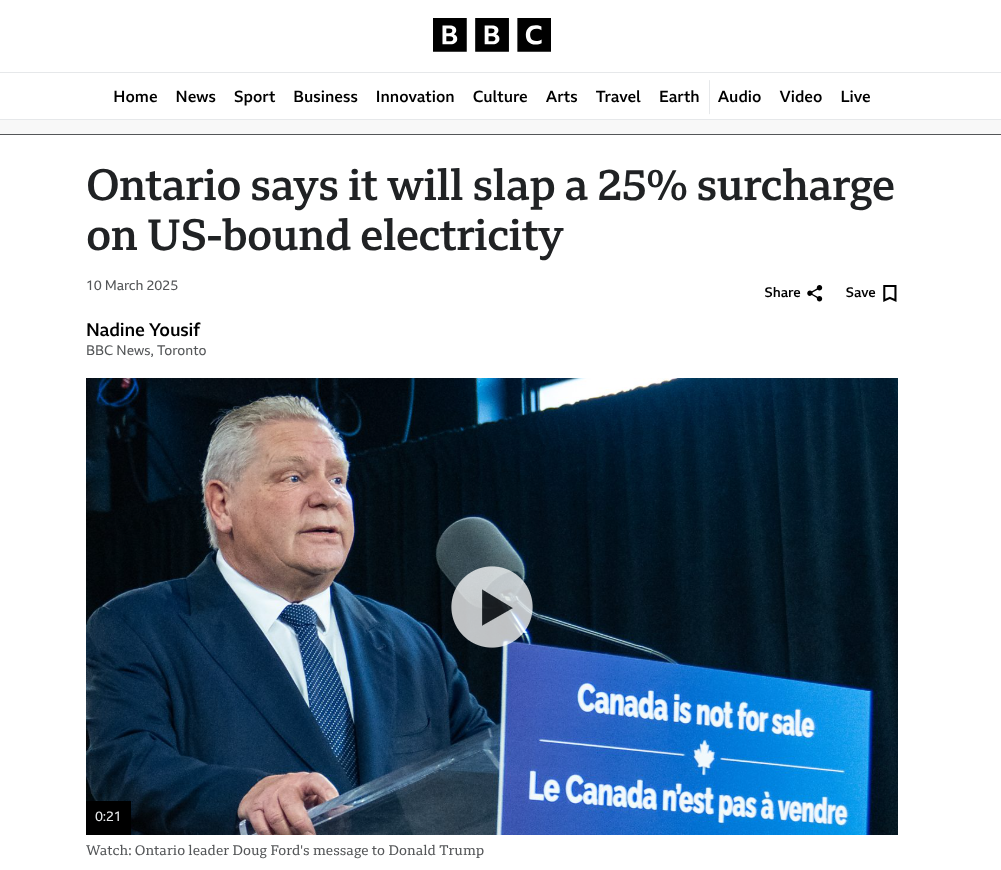
Bill 5 made changes to the Electricity Act, giving the government authority to direct IESO and OPG procurement, meaning the government can tell these organizations where they can and cannot purchase goods and services. The bill protects the government and its agencies from any lawsuits related to these changes.
The IESO, or Independent Electricity System Operator, manages Ontario’s energy system. OPG, or Ontario Power Generation, is a crown corporation responsible for generating about half of all electricity used in the province, and is responsible for generating electricity at regulated rates.
Corruptario is a reader-supported publication. To receive new posts and support our work, consider becoming a free or paid subscriber. If you find this work valuable, you can leave us a tip!
The remaining half of electricity in Ontario is generated from private and public companies, such as Bruce Power (owned by TC Energy and OMERS), Capital Power (whose shareholders include Fidelity Investments, Vanguard Group and BlackRock), TransAlta (a public company whose institutional investors include Brookfield Asset Management), and Enbridge. By tying the hands of IESO and OPG, the government could potentially create or protect opportunities and advantages for private and publicly-traded players.
Via amendments to the Ontario Energy Board Act, the government gives itself the same authority to direct procurement at gas companies and their subsidiaries too, as well as licensed energy companies and their subsidiaries. Unsurprisingly, it also protects itself from any legal action against the government based on these rules.
As private and publicly-traded companies in the energy space seek to increase profits, they must increase their rates, expand markets and/or increase their market share, making them very interested in access to the US market. These companies support Ford’s Fortress plan as they see it as an opportunity to grow. Undoubtedly, these same companies will lobby the Ford government to use its procurement control at IESO and OPG in ways that benefit their own opportunities and profitability.
Critical Minerals
Bill 5 actually changes the purpose of the Mining Act, now requiring that mining and exploration be balanced with “protecting Ontario’s economy.” It gives the Minister sweeping power under the guise of “national security” to shut down parts of the mining administration system (like claim registration) to “protect Canada’s supply of important minerals.”
Bill 5 gives the Minister power to suspend an account, ban someone from registering or getting a prospector’s license, cancel a prospector license, and cancel or block existing mining leases. Bill 5 also creates a “mine permitting team” set up by the Minister, to help move certain mining projects along faster.
As is standard operating procedure for the Ford government, the bill also protects the government from being sued for any of these changes.
Clearly, these measures protect the interests of the companies and individuals with current rights and permits in Ring of Fire and elsewhere.
Juno Corp, formed in 2019 with the goal of “systematically making discoveries in the Ring of Fire”, has accumulated vast mineral claim holdings in the area. According to its investor presentation, Juno is the largest mineral claim holder, with 52% of all mineral claims in the Ring of Fire.
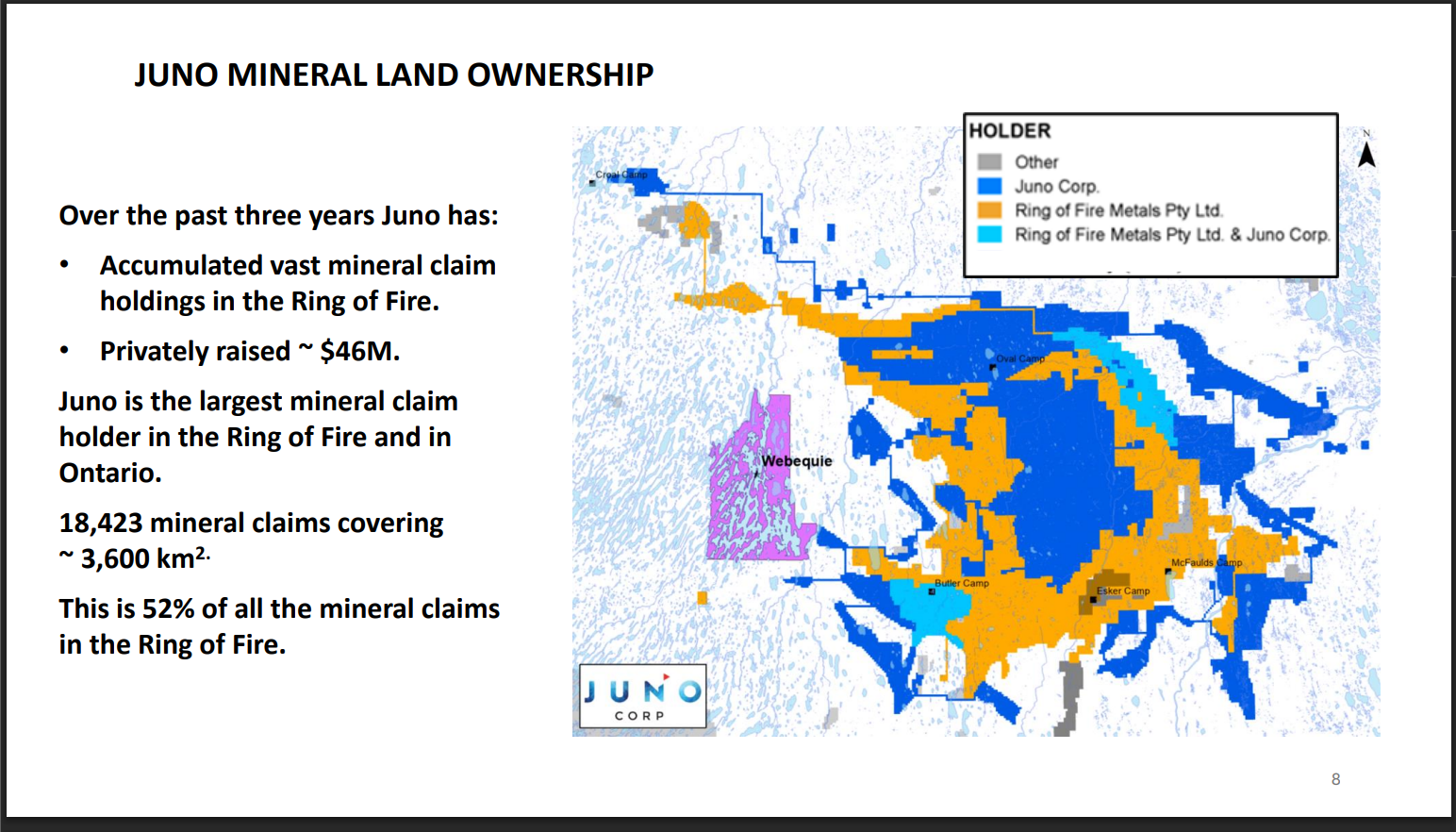
Ernie Eves, former Ontario premier and finance minister, is a director of Juno.
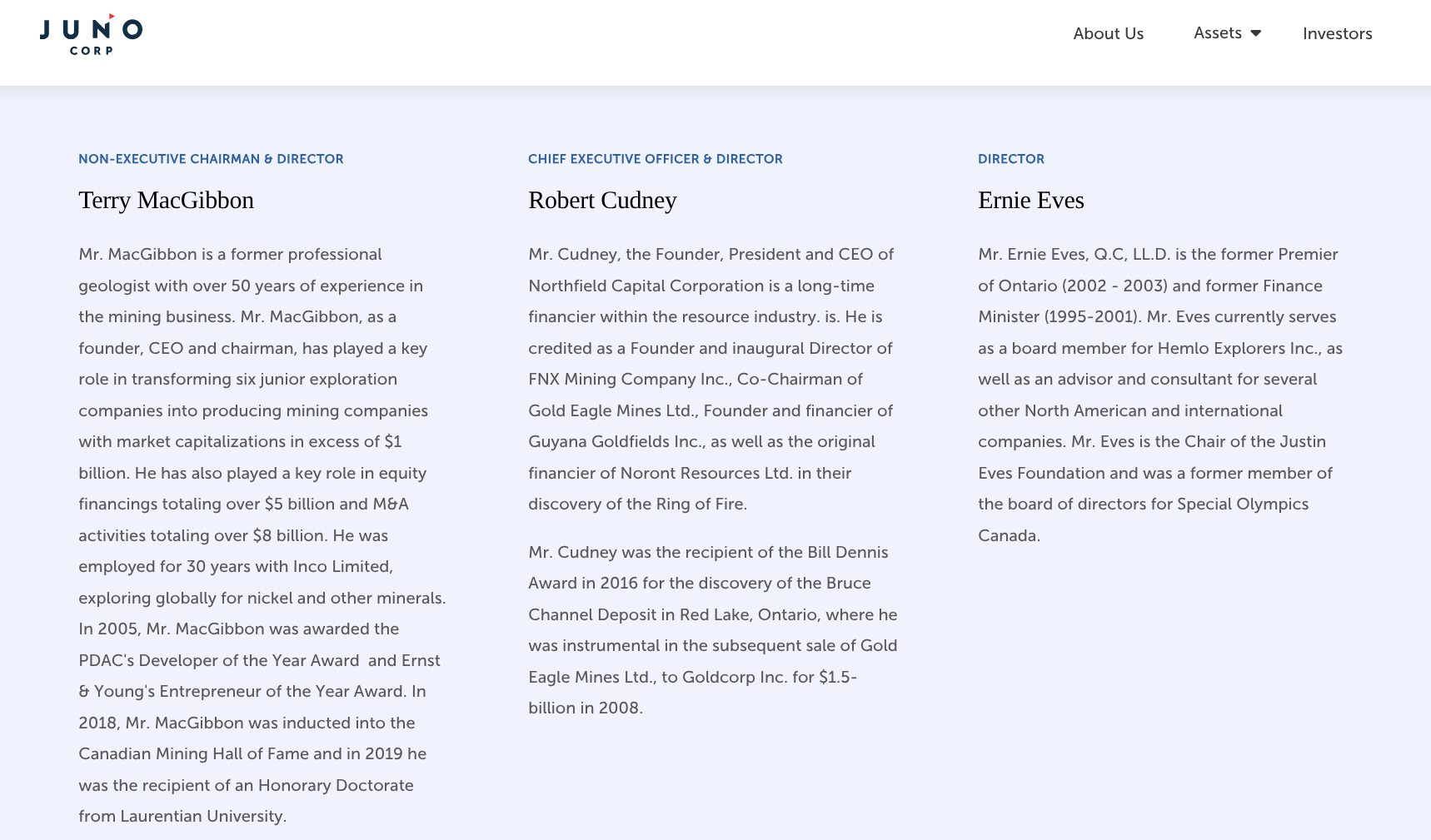
Interestingly, Bill 5 also makes amendments to the Ontario Heritage Act, substantially expanding the government’s authority over archeological matters in Ontario.
The Minister of Mining now has new inspection powers to check a site for artifacts and archeological sites, and these inspections can only happen on the Minister’s orders. The Minister can issue stop orders on work, and can seize artifacts, including entering a business premises to do so.
Notably, the Lieutenant Governor can exempt certain properties from following heritage protection rules if it supports a major “provincial goal”, and the government is shielded from any resulting legal action.
The Ford government’s interest in artifacts may be more about giving itself new inspection powers than any interest in conservation. However, and notably, the Ford government has appointed board members and executives to key heritage institutions (for example, the McMichael Canadian Art Collection and Royal Ontario Museum) from sectors, companies and institutions that are mutually supportive.
An example would be the McMichael Canadian Art Collection, where Andrew Pringle is currently the provincially-appointed chair. Pringle is a close ally of Ford, a former chair of the PC Ontario (the party’s fundraising arm) and ex-chair of the Toronto Police Services Board).

Next week, in part two - a look at who benefits from Special Economic Zones, and how Ford and Carney are aligned on the push to extract fast
